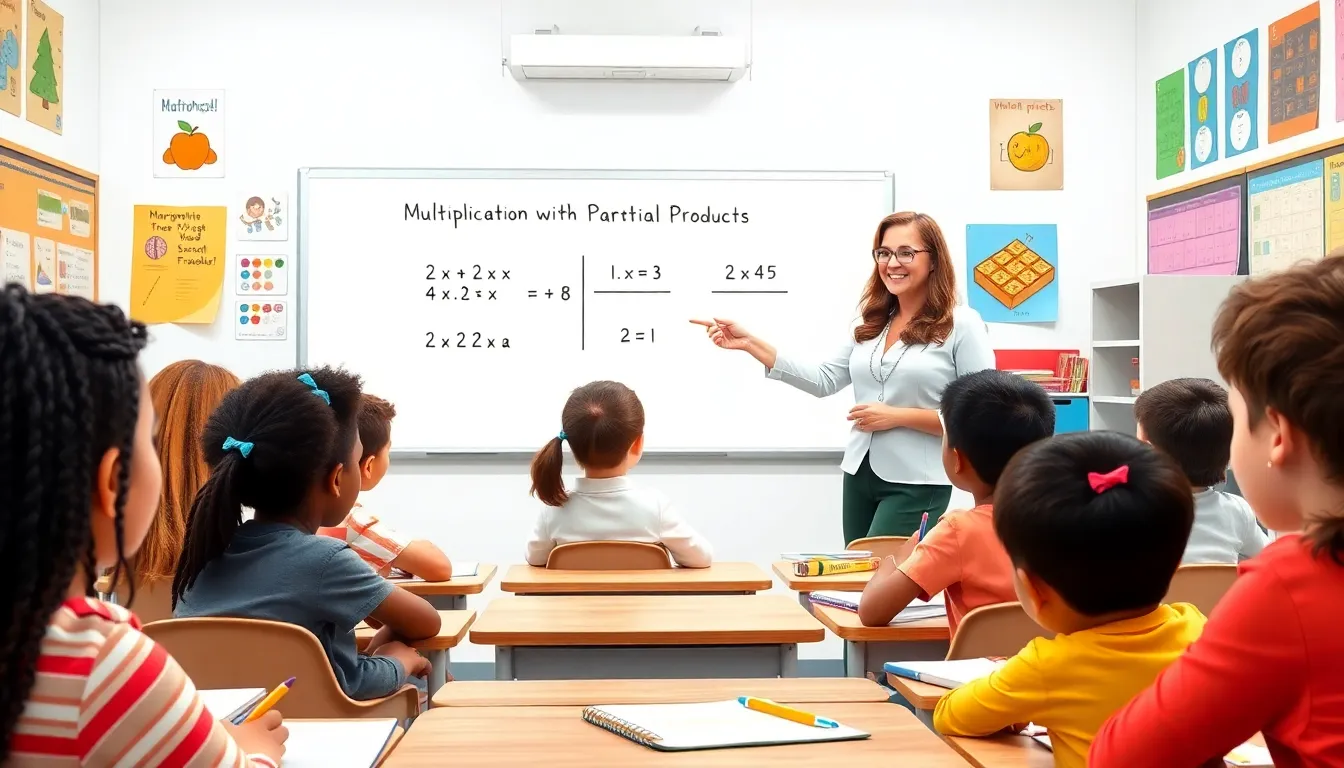Table of Contents
ToggleWhen it comes to multiplication, many folks get tangled in the web of numbers. Enter the partial product method—a superhero in the world of math that swoops in to save the day! It breaks down multiplication into manageable chunks, making it easier to tackle even the most daunting equations.
Understanding Partial Product
Partial products serve as a fundamental aspect of multiplication. This method simplifies complex problems by breaking them into smaller, manageable components.
Definition of Partial Product
A partial product arises when numbers are multiplied using a specific technique. Each digit from one multiplicand multiplies every digit from the other multiplicand, generating individual products. For example, when multiplying 23 by 47, breakdowns occur as follows: 20 times 40, 20 times 7, 3 times 40, and 3 times 7. Adding these products together culminates in the final result of the multiplication.
Importance in Mathematics
The partial product method enhances comprehension in mathematics. By separating multiplication into distinct parts, learners grasp the concept more effectively. It strengthens mental math skills and aids in understanding place value. Additionally, this technique lays the groundwork for more advanced multiplication strategies, fostering confidence in problem-solving abilities and ensuring a solid foundation in arithmetic.
How Partial Products Work

Partial products simplify multiplication by breaking it down into smaller, manageable steps. This method involves multiplying each digit of one number by each digit of the other number and summing the individual products.
Step-by-Step Calculation
First, separate the multiplicands into their place values. For example, in the multiplication of 23 by 47, separate 23 into 20 and 3, and 47 into 40 and 7. Next, calculate each product: 20 times 40 equals 800, 20 times 7 equals 140, 3 times 40 equals 120, and 3 times 7 equals 21. Finally, sum these results: 800, 140, 120, and 21 amounts to 1,081. This organized approach allows for easier problem-solving and enhances understanding of multiplication.
Examples of Partial Products
For instance, consider multiplying 56 by 32. First, break 56 into 50 and 6, and 32 into 30 and 2. Compute the individual products: 50 times 30 equals 1,500, 50 times 2 equals 100, 6 times 30 equals 180, and 6 times 2 equals 12. When combined, the sums—1,500, 100, 180, and 12—yield a final product of 1,792. Such examples demonstrate the effectiveness of partial products in simplifying multiplication tasks.
Applications of Partial Products
Partial products play a vital role in simplifying calculations, especially in multiplication. This method aids learners in breaking down larger problems into digestible components, making the processes more approachable.
Use in Multiplication
Partial products facilitate multiplication by decomposing numbers into their place values. When multiplying 23 by 47, each digit of one number interacts with every digit of the other, producing individual products like 800, 140, 60, and 21. These products merge to yield the final result of 1,081. Teachers often incorporate this method into lessons, providing students with a clearer understanding of multiplication mechanics. By reinforcing calculations through this strategy, students often develop better numerical fluency, making multiplication more intuitive.
Role in Algebra
In algebra, partial products assist in polynomial multiplication and factorization tasks. The method’s breakdown approach extends to variables, enabling effective handling of expressions like (x + 3)(x + 2). Here, students calculate each term separately, producing results such as x^2, 2x, 3x, and 6. Combining these products leads to a simplified equation, x^2 + 5x + 6. Utilizing partial products enhances algebraic skills, leading to improved problem-solving capabilities and fostering a deeper comprehension of polynomial behavior. This use bridges elementary concepts with advanced mathematical techniques.
Common Misconceptions
Many individuals misunderstand the concept of partial products. It’s often confused with direct multiplication or the traditional multiplication method. Direct multiplication involves a straight calculation of the entire numbers, while partial products segment the numbers into smaller components for easier computation.
Confusing Partial Products with Other Concepts
Some may mistake partial products for the distributive property or area models. While they share similarities, partial products specifically refer to the products obtained from multiplying each digit of one number by all digits of another. Area models, on the other hand, visualize multiplication using rectangles, which can lead to misconceptions about their interrelation with partial products.
Clarifying Misunderstandings
Misunderstandings often arise around the application of partial products. They are not limited to whole numbers; fractions and decimals can also utilize this approach. Additionally, students might believe this strategy only suits basic problems. In reality, partial products can simplify complex multiplication across various levels, reinforcing mathematical concepts and enhancing comprehension.
The partial product method stands out as a valuable tool in mastering multiplication. By breaking down numbers into their place values and calculating individual products, it not only simplifies complex problems but also enhances understanding and retention of mathematical concepts. This technique fosters confidence in learners and equips them with essential skills that extend beyond basic arithmetic. As students become more familiar with partial products, they gain a deeper appreciation for multiplication’s structure, paving the way for success in more advanced mathematical topics. Embracing this method can lead to improved problem-solving abilities and a solid foundation for future learning.







